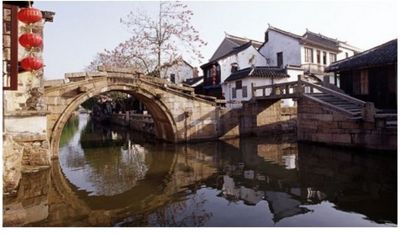Transformation of the historical town of WuZhen, China
| Name | Transformation of the historical town | |
| Place | WuZhen | |
| Country | China | |
| Author(s) | Chengkang Ye, Yiting Wei | |
| Project start | enter the date of the project start | |
| Completion | enter the date of completion | |
| World Heritage | enter the year of listing | |
| Client | enter the client | |
| Project costs | enter the costs (if known) | |
|
<googlemap version="0.9" lat="30.768979" lon="120.486374" type="map" zoom="9" width="400" height="300" controls="small">30.734163, 120.495987The historical town of WUZHEN</googlemap> | ||
Rationale: Why is the case study interesting?
- An experimental approach to preserving a historical town in East China.
Though the preservation of this traditional water town scenery was not only a simple desire to remain and improve a regional landscape, it was with an aspiration to achieve economic profits, the program did improve the visual scenery , and did help to raise the awareness of cultural landscape. By the mean time, problems produced by the whole program make us to rethink the planning method, e.g. the inadequate concern of the balance of inhabitants’ daily life and the tourism.
Author's perspective
- We hope we can learn following issues from this case study: one of possible approaches to preserve a historical town; thinking about how to improve the function for this town, and at the same time, to preserve a traditonal view of the fansy street scape and the attractive building-street-river space.
Cultural landscape context
- Biogeography, cultural features, overall landscape character, history and dynamics
Illustration: Map; sketches; short descriptive analyses
Socio-political context
- Brief explanation of political economy, legal framework
Illustration: Bullet points, image, background notes
Spatial analysis of area/project
- What are the main structural features?
- How has it been shaped? Were there any critical decisions?
Illustration: Map/diagram/sketches photos and background notes
Analysis of idea/program/function ("Planning Objective")
- What are the main functional characteristics?
- How have they been expressed or incorporated?
Illustration: Map/diagram/sketches photos and background notes
Analysis of design/planning process ("Process Biography")
- How was the area/project formulated and implemented?
- Who initiated the project and why?
- Which stakeholders have been involved?
- Who made the major decisions and when?
- Were there any important consultations/collaborations?
Illustration: Map/diagram/sketches photos and background notes
Analysis of use/users
- How is the area/project used and by whom?
- Is the use changing? Are there any issues?
Illustration: Map/diagram/sketches photos and background notes
Future development directions
- How is the area/project evolving?
- Are there any future goals?
Illustration: Map/diagram/sketches photos and background notes
Peer reviews or critique
- Has the area/project been reviewed by academic or professional reviewers?
- What were their main evaluations?
Please add references, quotes...
Successes and limitations
- What do you see as the main successes and limitations of the area/project?
Illustration: Summary table
What can be generalized from this case study?
- Are there any important theoretical insights?
Short statement plus background notes
What research questions does it generate?
Short statement plus background notes
Image Gallery
- Yourimage.jpg
your image text and source
- Yourimage.jpg
your image text and source
- Yourimage.jpg
your image text and source
- Yourimage.jpg
your image text and source
- Yourimage.jpg
your image text and source
- Yourimage.jpg
your image text and source
- Yourimage.jpg
your image text and source
- Yourimage.jpg
your image text and source
References
- Author Year: Title, publisher, edition, page, ...
- etc.
- Website Year: Link, keyword, ...
- etc.
